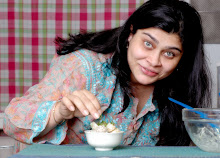
The Kantolas
And Vikram's excellent column on Bhajji galli ~
"Mumbai has many good vegetable markets, but Bhaji Gali near Grant Road station is one of the best. Probably because many vegetarian Maharashtrians and Gujaratis live nearby, the veggies always seem extra good and fresh. Another sign that it’s a good market is how sellers specialise."
And it's treasures within including Moras bhajji ~
"A few sellers away I spotted a bag of leaves half hidden under other veggies. They looked odd, long and fleshy ovals that I almost thought were discarded bean pods, but they had the thick stems of a succulent. The vegetable seller called them moras-bhaji and he told me it grew near the sea, coming to them from the beaches at Vasai. "
... finally had me calling him to fix a day to go marketing together. It is something we have been meaning to do but not getting around too. Ignoring pangs of guilt I left the DH with my able housekeeper, Shobha to look after the kids and drove into town. I was really looking forward to this trip since I had been pretty much confines to my colony the last couple of weeks thanks to kids work and the monsoons. The rain gods were also indulgent and held themselves back for me.
We met at the Grant rd. station side. The plan was to walk through to the other side and then drive on to our next destination. Almost immediately we got down to shopping since one of the vendors I especially wanted to visit was right at the corner on which we met. The water chestnut seller.
Water chestnuts come into season at this time of the year, and I had been wanting to get my hands on some for a while now but they are not available near where I live in Powai.
I discovered Water Chestnuts in their fresh form at Mayo girls where we would sometimes get them for tea. Prior to that I had only eaten the cooked salted ones.
Fresh water chestnuts are extremely different from their cooked counterparts and I must say I like them better; tender, crunchy, sweet, juicy and faintly herby, they are great to eat raw and absolutely delicious in curries. A fact I discovered entirely by chance a few years ago when. Anticipating a day of many acquisitions I conservatively bought just half a kg and ended up wishing I'd exercised the judgment to buy more because the were over before I could savor them.
Tucking them into my shopping bag, I moved on with Vikram. We saw a whole lot of other vegetables, identifying them and telling each other how we used them, until we came to the Moras vegetable guy. In fact we almost missed the basket full of Moras he was selling, because it was buried under a bunch of green bananas as you can see in the picture. A little later we happened upon a vendor selling Kantolas. These are prickly little things that my husband confirmed are the Meethe Karele of Uttarakhandi cuisine. All too soon we'd finished with this short stretch of a vegetable wonderland and emerged at the other end.
My Dadi, swore by two markets, Bhulleshwar and Bhajji galli, but Bhuleshwar was further away. Bhajji galli (which literally translates to vegetable lane) was very close and extremely accessible.
Bhajji Gali is a small lane that stretches on a perpendicular from Grant road station. Which makes it a popular stop for commuters to shop for vegetables on their way home. We visited in the lax hours, so vendors were patient with us but try come peak hours and a cacophony of hundreds of voices will greet you selling everything from tomatoes to greens. The fact that it is right in the middle of the vegetarian gujarati populated area makes it a treasure trove for indigenous seasonal vegetables.


















